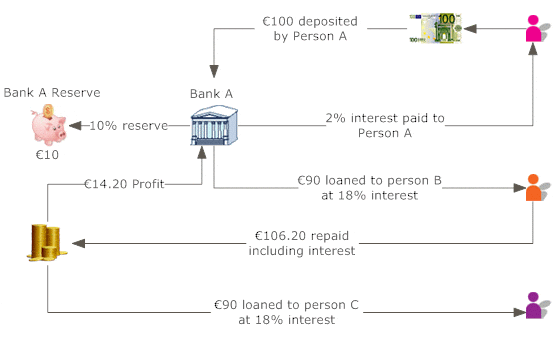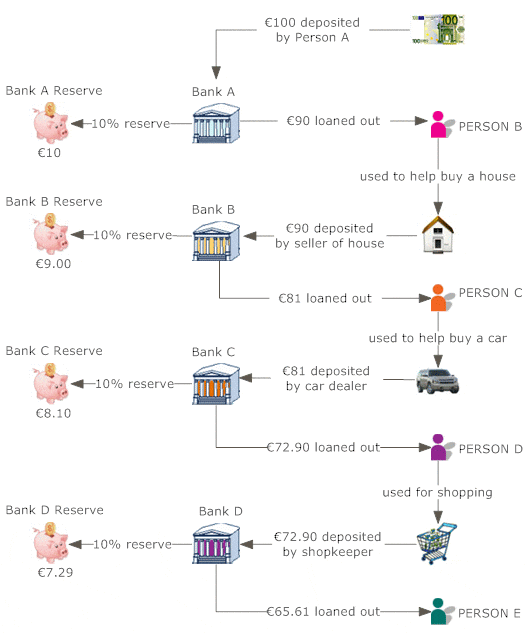How Banks Work
Banks accept deposits and make loans and make a profit from the difference in the interest rates paid on deposits and charged for loans. Banks work because of our trust. We give a bank our money to keep it safe for us, and then the bank lends it to someone else in order to make money for itself. Banks can legally lend far more money than they have cash. Still, most of us have total trust in the bank's ability to protect our money and give it to us when we ask for it.

|
Animation: how banks make money |
Banks create money in the economy by making loans. The amount of money that banks can lend is directly affected by the reserve requirement set by the Central Bank (in the UK, the Bank of England and the Federal Reserve Bank in the US). The US Federal Reserve Bank reserve requirement for a large bank is currently 10 percent of its total deposits (11.01.2016). This amount can be held either in cash in the bank's vaults or in the bank's reserve account with the Central Bank.
To see how this affects the economy, think about it like this. When a bank gets a deposit of €100, assuming a reserve requirement of 10 percent, the bank can then lend out €90. That €90 goes back into the economy, purchasing goods or services, and usually ends up deposited in another bank. That bank can then lend out €81 of that €90 deposit, and that €81 goes into the economy to purchase goods or services and ultimately is deposited into another bank that proceeds to lend out a percentage of it. In this way, illustrated below, money grows and flows throughout the community in a much greater amount than physically exists. That initial €100 deposit makes a much larger ripple in the economy than you may realise!
 |
Animation: how banks work |
How did it start?
Our method of banking originated with the goldsmiths - the
predecessors of our present bankers. The goldsmiths noticed that the people who
deposited gold with them for safekeeping only withdrew a small amount at any one
time. The goldsmiths realised that they could lend out a lot of the gold left
with them by issuing paper receipts to borrowers for gold they did not own. The
goldsmiths would make money by charging interest on the loans. Loans were often
secured with a pawn of silver plate or jewellery and the receipts circulated as
money. There were soon several receipts in circulation for one amount of gold,
the origins of our system of Fractional Reserve Banking where much
greater sums of money are lent out than assets held by the banks.
A person who took a paper receipt for gold in payment for goods or services
could either save it, spend it, or exchange it for the gold in the goldsmith’s
keeping. If there was a run of two or more people who suddenly wished to
retrieve their gold, the goldsmith could usually rely on the fact that he had
debtors who owed him gold, although they had originally received nothing but a
piece of paper. They had to pay him in gold. Should they default, the goldsmith
could sell their pawned possessions, buy gold, and settle the claims.
Why does it work?
Our economy depends upon banks lending money. Bank loans to businesses help create many jobs. Without a bank mortgage it would take most of our working lives to save the cash to buy a family home. But banking is all about trust. We trust that the bank will have our money for us when we go to get it. We trust that it will honour the cheques we write to pay our bills. The thing that's hard to grasp is the fact that while people are putting money into the bank every day, the bank is lending that same money and more to other people. Banks consistently lend far more money than they have cash. That's a little scary; but if you go to the bank and demand your money, you'll get it. However, if everyone goes to the bank at the same time and demands their money there wouldn’t be enough leading to panic called a run on the bank.
 |
| A run on a bank in Berlin, 13 July 1931. Depositors clamour to withdraw their savings. |
| Attribution: Bundesarchiv, Bild 102-12023 Georg Pahl CC-BY-SA 3.0 |
The key to the success of banking lies in the confidence that customers have in their bank's ability to protect their money. Because banks rely so heavily on customer trust, and trust depends on the perception of integrity, the banking industry should always be highly regulated by the government. Where bank regulations have been relaxed or deregulated (e.g. USA, UK and Iceland, 2008), financial chaos has been the result.
|
The 2008 US Banking Crisis A housing boom in the US was stimulated by cheap loans fuelled by billions of dollars of investment of the massive savings and surpluses of China and other Asian economies. This sucked in many people who borrowed money in order to purchase homes that were far more expensive than their ability to meet their mortgage obligations. This ultimately led to the collapse of the banking system under a mountain of debt. Reckless borrowing was encouraged by the US government who pressured mortgage providers to lower their lending standards in order to make home ownership more affordable for low income groups. This led to 'NINJA' loans for borrowers with 'No Income, no Job or Assets' and self-certified loans, commonly called 'liars loans' for homebuyers to purchase homes of their dreams. Initially, homebuyers were able to meet their mortgage obligations due to their low "teaser" rates of as little as 1% in the first few years. However, many homeowners were stunned when their adjustable-rate mortgages began to reset to much higher rates in mid-2007 and their monthly payments jumped far above their ability to meet the monthly mortgage payments. Some borrowers began to default on their mortgages in mid-2007 and the cracks in the U.S. housing market and banking system began to appear. The banks had lent far more than the value of their reserves, and were now unable to sell repossessed homes to recover their loans. Until the mid-'90s, banks had to keep huge amounts of money in reserve in case any of their loans went bad. Banking law was changed enabling banks to reduce their vulnerability by taking the loans they had made and selling them on to investors. The deals grew so complex that bank executives and regulators did not understand them, and banks discouraged government oversight of their activities, saying the interference would stifle financial innovation. Bankers also hit on a sort of insurance policy: the world's largest insurance company, American International Group (AIG), would take on the risk of debts going bad, and in exchange would receive regular payments from the banks, similar to insurance premiums. Banks would then get to remove the risk from their books and free up their reserves in order to lend even more money. These schemes to reduce risk were to completely fail, but in the meantime US investment banks were soon lending 40 times the value of their reserves. US Government sponsored mortgage giants Freddie Mac and Fannie Mae were using lending ratios (leverage) closer to 100 to 1. Banks like high leverage because it allows them to make many loans, and therefore lots of money, with only a small amount of capital (cash) at stake. In good times, high leverage is a great way to make fantastic investment returns. In bad times, though, even small losses in a highly leveraged bank can completely wipe its reserves and make it insolvent. Insolvency for many arrived by August 2008 when highly leveraged banks found themselves hopelessly over-extended as the U.S. property market hit an all-time low. Houses were selling for just 50 PENCE. The decline in housing values quickly emptied the banks' reserves, leading to the collapse or taxpayer bailout of Wall Street's biggest names: Goldman Sachs, Morgan Stanley, Merrill Lynch, Lehman Brothers, Bear Stearns, Citigroup, the world's largest insurers, AIG, and the US's largest bank, Bank of America. While the public were gnashing its teeth at funding a $700
billion bank rescue, there were handsome winners. Wall Street's five biggest
banks paid a record $39 billion in bonuses to their employees for 2007, larger
than the gross domestic products of Sri Lanka, Lebanon or Bulgaria. The average
bonus of $219,198 was more than four times higher than the median U.S. household
income in 2006, according to data compiled by the U.S. Census Bureau. The risk-taking entrepreneurs failed, leading to the greatest destruction of world wealth since the devastation of World War 2. But the collapse of the banking system under a mountain of debt may be seen as a symptom and not the cause of the financial crisis. It is the imbalance in trade and financial flows between the US and China that lies at the root of the banking crisis, some bankers believe, with the US and the West maintaining an unsustainable standard of living by going ever deeper into debt. Cheng Siwei, head of China's green energy drive, agrees. "He who goes borrowing, goes sorrowing," he said, quoting from US founding father Benjamin Franklin. "The US spends tomorrow's money today, we Chinese spend today's money tomorrow. That's why we have this financial crisis." Any ultimate resolution of the financial crisis may require a rebalancing of trade and financial flows between the world’s ageing and emerging superpowers, with the US taking the advice it normally gives poorer countries: export more and spend less. |
|
"I think that people have learned that money
is not made in banks. It is made by real people working hard at real jobs.
Actually, deep down we knew that all along. We just have to learn it
again." |
| Sources: | China alarmed by US money printing, Daily Telegraph 07.09.2009 |
